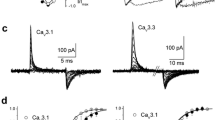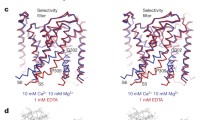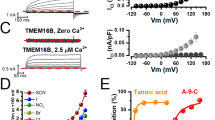Abstract
Extracellular acidification decreases Ca2+ current amplitude and produces a depolarizing shift in the activation potential (Va) of voltage-gated Ca2+ channels (VGCC). These effects are common to all VGCC, but differences exist between Ca2+ channel types and the underlying molecular mechanisms remain largely unknown. We report here that the changes in current amplitude induced by extracellular acidification or alkalinisation are more important for Cav2.3 R type than for Cav2.1 P/Q-type Ca2+ channels. This difference results from a higher shift of Va combined with a modification of channel conductance. Although involved in the sensitivity of channel conductance to extracellular protons, neither the EEEE locus nor the divalent cation selectivity locus could explain the specificity of the pH effects. We show that this specificity involves two separate sets of amino acids within domain I of the Cavα subunit. Residues of the voltage sensor domain and residues in the pore domain mediate the effects of extracellular protons on Va and on channel conductance, respectively. These new insights are important for elucidating the molecular mechanisms that control VGCC gating and conductance and for understanding the role of extracellular protons in other channels or membrane-tethered enzymes with similar pore and/or voltage sensor domains.








Similar content being viewed by others
Abbreviations
- VGCC:
-
Voltage-gated Ca2+ channels
- HVA:
-
High voltage activated
- LVA:
-
Low voltage activated
- DCS:
-
Divalent cations selectivity
- Va:
-
Activation potential
- VSD:
-
Voltage sensor domain
- pHo:
-
Extracellular pH
- G :
-
Maximal whole cell conductance
References
Bezanilla F (2008) How membrane proteins sense voltage. Nat Rev Mol Cell Biol 9:323–332
Carlin KP (2005) Modulation of calcium currents in mouse ventral horn neurons by extracellular pH. Eur J Neurosci 22:2655–2660
Catterall WA (1998) Structure and function of neuronal Ca2+ channels and their role in neurotransmitter release. Cell Calcium 24:307–323
Cens T, Dalle C, Charnet P (1998) Expression of beta subunit modulates surface potential sensing by calcium channels. Pflugers Arch 435:865–867
Cens T, Leyris JP, Charnet P (2008) Introduction into Ca(v)2.1 of the homologous mutation of Ca(v)1.2 causing the Timothy syndrome questions the role of V421 in the phenotypic definition of P-type Ca(2+) channel. Pflugers Arch 457:417–430
Cens T, Mangoni ME, Nargeot J, Charnet P (1996) Modulation of the alpha 1A Ca2+ channel by beta subunits at physiological Ca2+ concentration. FEBS Lett 391:232–237
Cens T, Restituito S, Rousset M, Charnet P (2005) Role of β subunits in voltage-gated calcium channel functions. In: Zamponi GW (ed) Voltage gated calcium channels. Landes Bioscience, Georgetown, Texas, USA, pp 95–112
Cens T, Rousset M, Kajava A, Charnet P (2007) Molecular determinant for specific ca/ba selectivity profiles of low and high threshold Ca2+ channels. J Gen Physiol 130:415–425
Chen XH, Bezprozvanny I, Tsien RW (1996) Molecular basis of proton block of L-type Ca2+ channels. J Gen Physiol 108:363–374
Cukierman S, Zinkand WC, French RJ, Krueger BK (1988) Effects of membrane surface charge and calcium on the gating of rat brain sodium channels in planar bilayers. J Gen Physiol 92:431–447
Delisle BP, Satin J (2000) pH modification of human T-type calcium channel gating. Biophys J 78:1895–1905
Doering CJ, McRory JE (2007) Effects of extracellular pH on neuronal calcium channel activation. Neuroscience 146:1032–1043
Du J, Xie J, Yue L (2009) Modulation of TRPM2 by acidic pH and the underlying mechanisms for pH sensitivity. J Gen Physiol 134:471–488
Goodchild SJ, Lamy C, Seutin V, Marrion NV (2009) Inhibition of K(Ca)2.2 and K(Ca)2.3 channel currents by protonation of outer pore histidine residues. J Gen Physiol 134:295–308
Green WN, Anderson OS (1991) Surface charges and ion channel function. Annu Rev Physiol 53:341–359
Kang HW, Moon HJ, Joo SH, Lee JH (2007) Histidine residues in the IS3–IS4 loop are critical for nickel-sensitive inhibition of the Cav2.3 calcium channel. FEBS Lett 581:5774–5780
Kang HW, Park JY, Jeong SW, Kim JA, Moon HJ, Perez-Reyes E, Lee JH (2006) A molecular determinant of nickel inhibition in Cav3.2 T-type calcium channels. J Biol Chem 281:4823–4830
Kang HW, Vitko I, Lee SS, Perez-Reyes E, Lee JH (2010) Structural determinants of the high affinity extracellular zinc binding site on Cav3.2 T-type calcium channels. J Biol Chem 285:3271–3281
Khan A, Romantseva L, Lam A, Lipkind G, Fozzard HA (2002) Role of outer ring carboxylates of the rat skeletal muscle sodium channel pore in proton block. J Physiol 543:71–84
Klockner U, Mikala G, Schwartz A, Varadi G (1996) Molecular studies of the asymmetric pore structure of the human cardiac voltage-dependent Ca2+ channel. J Biol Chem 271:22293–22296
Li RA, Velez P, Chiamvimonvat N, Tomaselli GF, Marban E (2000) Charged residues between the selectivity filter and S6 segments contribute to the permeation phenotype of the sodium channel. J Gen Physiol 115:81–92
Pinchenko VO, Kostyuk PG, Kostyuk EP (2005) Influence of external pH on two types of low-voltage-activated calcium currents in primary sensory neurons of rats. Biochim Biophys Acta 1724:1–7
Richards KS, Swensen AM, Lipscombe D, Bommert K (2007) Novel CaV2.1 clone replicates many properties of Purkinje cell CaV2.1 current. Eur J Neurosci 26:2950–2961
Sather WA, McCleskey EW (2003) Permeation and selectivity in calcium channels. Annu Rev Physiol 65:133–159
Shah MJ, Meis S, Munsch T, Pape HC (2001) Modulation by extracellular pH of low- and high-voltage-activated calcium currents of rat thalamic relay neurons. J Neurophysiol 85:1051–1058
Smirnov SV, Knock GA, Belevych AE, Aaronson PI (2000) Mechanism of effect of extracellular pH on L-type Ca(2+) channel currents in human mesenteric arterial cells. Am J Physiol Heart Circ Physiol 279:H76–H85
Sun YM, Favre I, Schild L, Moczydlowski E (1997) On the structural basis for size-selective permeation of organic cations through the voltage-gated sodium channel: effect of alanine mutations at the DEKA locus on selectivity, inhibition by Ca2+ and H+, and molecular sieving. J Gen Physiol 110:693–715
Talavera K, Janssens A, Klugbauer N, Droogmans G, Nilius B (2003) Extracellular Ca2+ modulates the effects of protons on gating and conduction properties of the T-type Ca2+ channel alpha1G (CaV3.1). J Gen Physiol 121:511–528
Tang S, Mikala G, Bahinski A, Yatani A, Varadi G, Schwartz A (1993) Molecular localization of ion selectivity sites within the pore of a human L-type cardiac calcium channel. J Biol Chem 268:13026–13029
Tombaugh GC, Somjen GG (1996) Effects of extracellular pH on voltage-gated Na+, K + and Ca2+ currents in isolated rat CA1 neurons. J Physiol 493:719–732
Tombola F, Pathak MM, Isacoff EY (2006) How does voltage open an ion channel? Annu Rev Cell Dev Biol 22:23–52
Vacher H, Mohapatra DP, Trimmer JS (2008) Localization and targeting of voltage-dependent ion channels in mammalian central neurons. Physiol Rev 88:1407–1447
Xiong ZQ, Stringer JL (2000) Extracellular pH responses in CA1 and the dentate gyrus during electrical stimulation, seizure discharges, and spreading depression. J Neurophysiol 83:3519–3524
Yang J, Ellinor PT, Sather WA, Zhang JF, Tsien RW (1993) Molecular determinants of Ca2+ selectivity and ion permeation in L-type Ca2+ channels. Nature 366:158–161
Zamponi GW, Bourinet E, Snutch TP (1996) Nickel block of a family of neuronal calcium channels: subtype- and subunit-dependent action at multiple sites. J Membr Biol 151:77–90
Zamponi GW, Snutch TP (1996) Evidence for a specific site for modulation of calcium channel activation by external calcium ions. Pflugers Arch 431:470–472
Zhou W, Jones SW (1995) Surface charges and calcium channel saturation in bullfrog sympathetic neurons. J Gen Physiol 105:441–462
Acknowledgments
This work was supported by the “Centre Nationale de la Recherche Scientifique”, the “Institut Nationale de la Santé Et de la Recherche Médicale”, the “Fondation Simone & Cino Del Duca”, the “Fondation pour la Recherche sur le Cerveau”. We thank T. Snutch and E. Perez-Reyes for kindly providing calcium channels cDNAs, J-M. Donnay and J-C Mazur for oocyte preparations.
Author information
Authors and Affiliations
Corresponding author
Rights and permissions
About this article
Cite this article
Cens, T., Rousset, M. & Charnet, P. Two sets of amino acids of the domain I of Cav2.3 Ca2+ channels contribute to their high sensitivity to extracellular protons. Pflugers Arch - Eur J Physiol 462, 303–314 (2011). https://doi.org/10.1007/s00424-011-0974-x
Received:
Revised:
Accepted:
Published:
Issue Date:
DOI: https://doi.org/10.1007/s00424-011-0974-x




